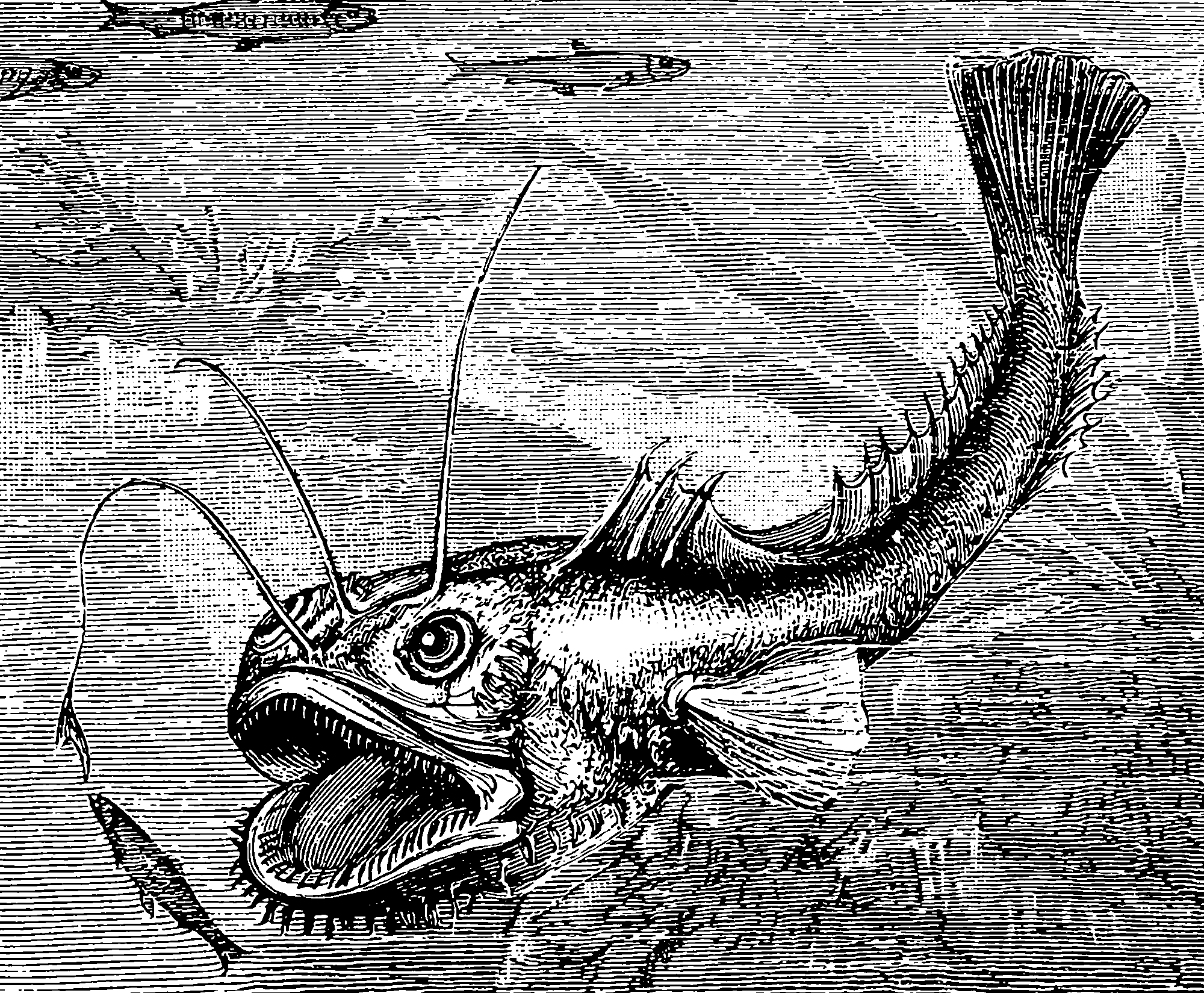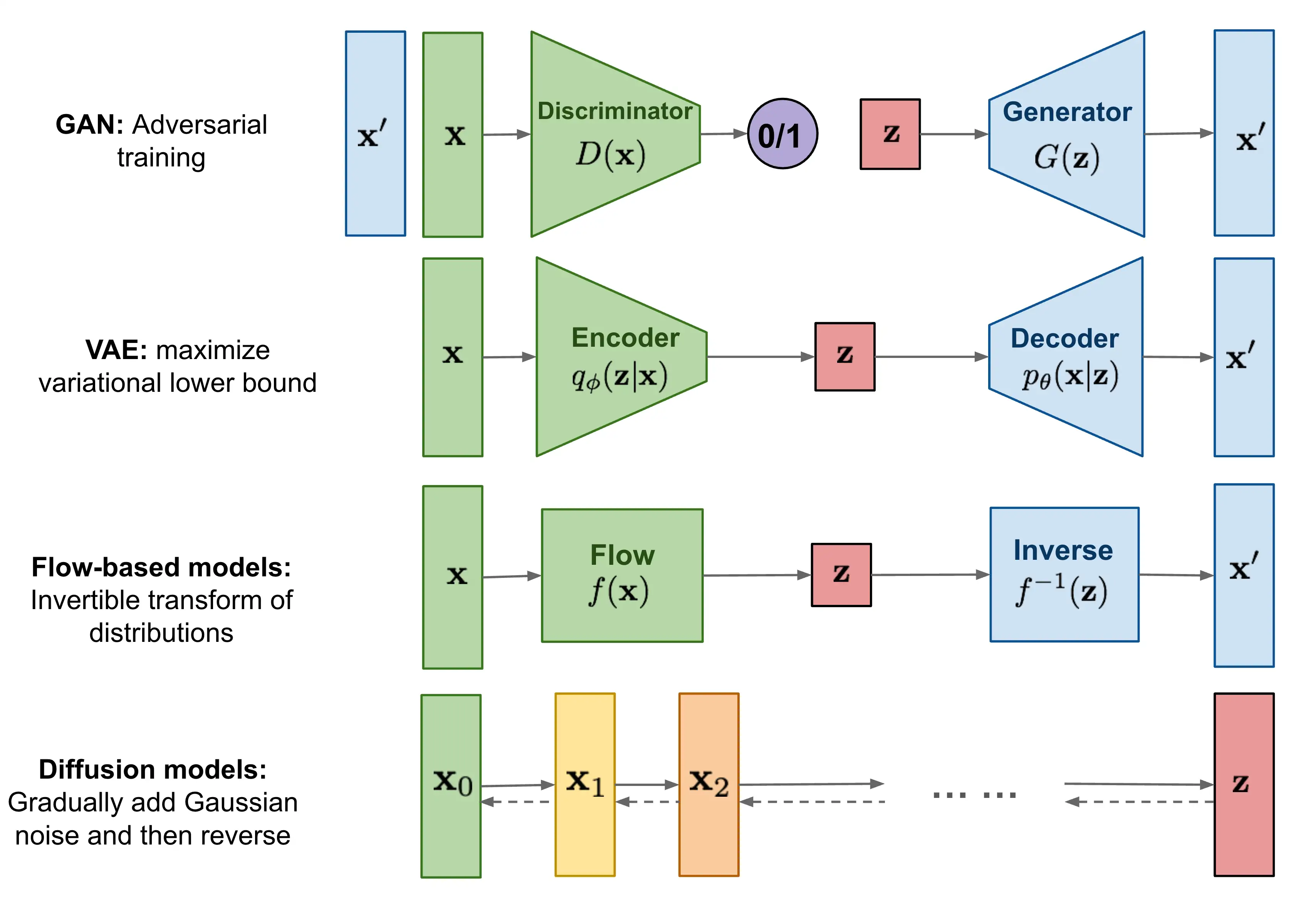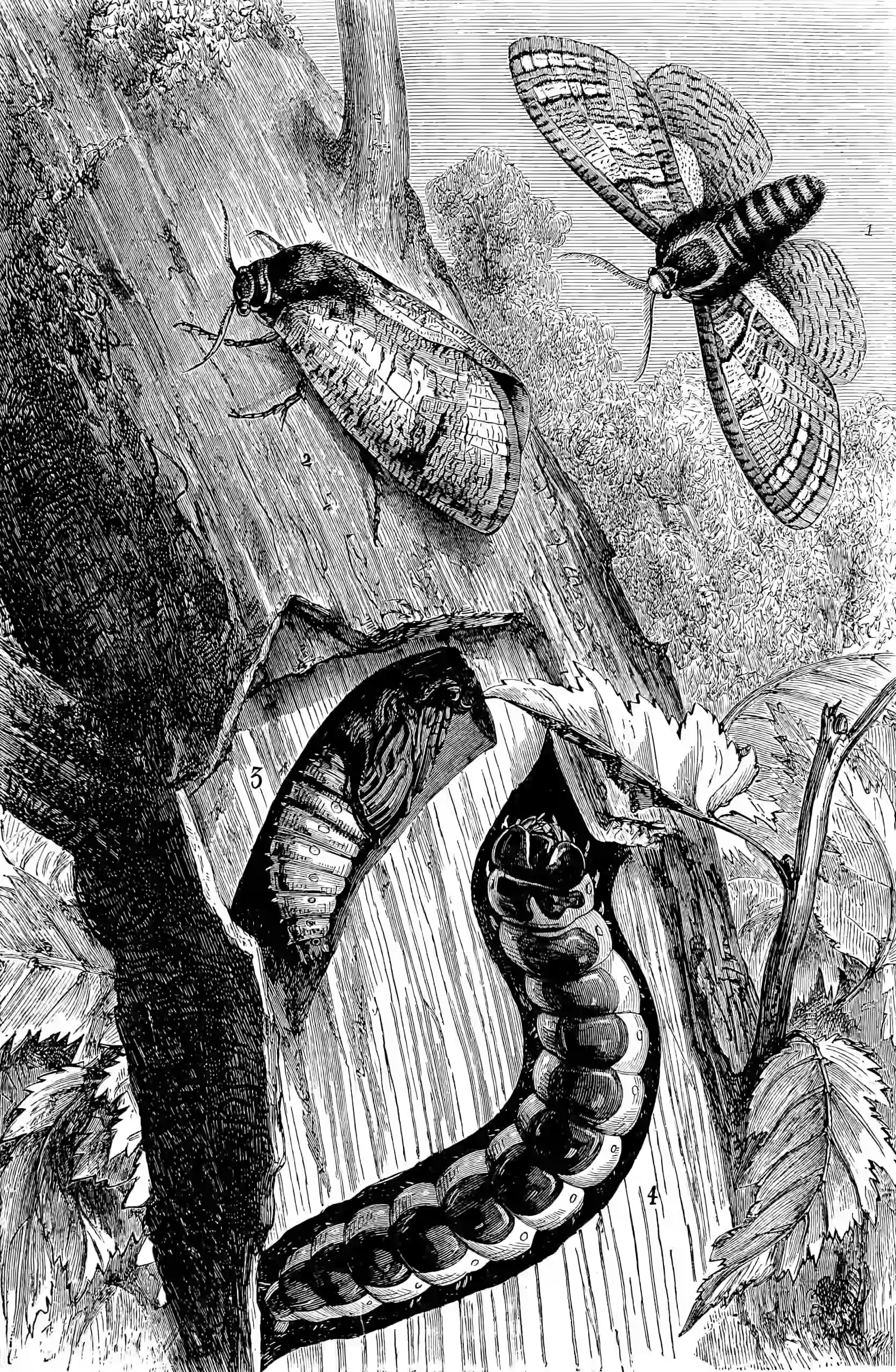Adler, and Lunz. 2018.
“Banach Wasserstein GAN.”
Anderson. 1982.
“Reverse-Time Diffusion Equation Models.” Stochastic Processes and Their Applications.
Arjovsky, Chintala, and Bottou. 2017.
“Wasserstein Generative Adversarial Networks.” In
International Conference on Machine Learning.
Bach, He, Ratner, et al. 2017.
“Learning the Structure of Generative Models Without Labeled Data.” In
Proceedings of the 34th International Conference on Machine Learning.
Bora, Jalal, Price, et al. 2017.
“Compressed Sensing Using Generative Models.” In
International Conference on Machine Learning.
Bowman, Vilnis, Vinyals, et al. 2015.
“Generating Sentences from a Continuous Space.” arXiv:1511.06349 [Cs].
Burda, Grosse, and Salakhutdinov. 2016.
“Importance Weighted Autoencoders.” In
arXiv:1509.00519 [Cs, Stat].
Caterini, Doucet, and Sejdinovic. 2018.
“Hamiltonian Variational Auto-Encoder.” In
Advances in Neural Information Processing Systems.
Chen, Kingma, Salimans, et al. 2016.
“Variational Lossy Autoencoder.” In
PRoceedings of ICLR.
Dhariwal, and Nichol. 2021.
“Diffusion Models Beat GANs on Image Synthesis.” arXiv:2105.05233 [Cs, Stat].
Donahue, McAuley, and Puckette. 2019.
“Adversarial Audio Synthesis.” In
ICLR 2019.
Dosovitskiy, Springenberg, Tatarchenko, et al. 2014.
“Learning to Generate Chairs, Tables and Cars with Convolutional Networks.” arXiv:1411.5928 [Cs].
Dutordoir, Hensman, van der Wilk, et al. 2021.
“Deep Neural Networks as Point Estimates for Deep Gaussian Processes.” In
arXiv:2105.04504 [Cs, Stat].
Dutordoir, Saul, Ghahramani, et al. 2022.
“Neural Diffusion Processes.”
Dziugaite, Roy, and Ghahramani. 2015.
“Training Generative Neural Networks via Maximum Mean Discrepancy Optimization.” In
Proceedings of the Thirty-First Conference on Uncertainty in Artificial Intelligence. UAI’15.
Engel, Agrawal, Chen, et al. 2019.
“GANSynth: Adversarial Neural Audio Synthesis.” In
Seventh International Conference on Learning Representations.
Frühstück, Alhashim, and Wonka. 2019.
“TileGAN: Synthesis of Large-Scale Non-Homogeneous Textures.” arXiv:1904.12795 [Cs].
Gal, and Ghahramani. 2015. “On Modern Deep Learning and Variational Inference.” In Advances in Approximate Bayesian Inference Workshop, NIPS.
Genevay, Peyré, and Cuturi. 2017.
“Learning Generative Models with Sinkhorn Divergences.” arXiv:1706.00292 [Stat].
Goodfellow, Ian, Pouget-Abadie, Mirza, et al. 2014.
“Generative Adversarial Nets.” In
Advances in Neural Information Processing Systems 27. NIPS’14.
Goodfellow, Ian J., Shlens, and Szegedy. 2014.
“Explaining and Harnessing Adversarial Examples.” arXiv:1412.6572 [Cs, Stat].
Gulrajani, Ahmed, Arjovsky, et al. 2017.
“Improved Training of Wasserstein GANs.” arXiv:1704.00028 [Cs, Stat].
Guo, Hong, Lin, et al. 2017.
“Relaxed Wasserstein with Applications to GANs.” arXiv:1705.07164 [Cs, Stat].
He, Wang, and Hopcroft. 2016.
“A Powerful Generative Model Using Random Weights for the Deep Image Representation.” In
Advances in Neural Information Processing Systems.
Hinton. 2007.
“Learning Multiple Layers of Representation.” Trends in Cognitive Sciences.
Hoffman, and Johnson. 2016.
“ELBO Surgery: Yet Another Way to Carve up the Variational Evidence Lower Bound.” In
Advances In Neural Information Processing Systems.
Ho, Jain, and Abbeel. 2020.
“Denoising Diffusion Probabilistic Models.” In
Proceedings of the 34th International Conference on Neural Information Processing Systems. NIPS ’20.
Hoogeboom, Gritsenko, Bastings, et al. 2021.
“Autoregressive Diffusion Models.” arXiv:2110.02037 [Cs, Stat].
Husain, Nock, and Williamson. 2019.
“A Primal-Dual Link Between GANs and Autoencoders.” In
Advances in Neural Information Processing Systems.
Hu, Yang, Salakhutdinov, et al. 2018.
“On Unifying Deep Generative Models.” In
arXiv:1706.00550 [Cs, Stat].
Isola, Zhu, Zhou, et al. 2017.
“Image-to-Image Translation with Conditional Adversarial Networks.” In
2017 IEEE Conference on Computer Vision and Pattern Recognition (CVPR).
Jalal, Arvinte, Daras, et al. 2021.
“Robust Compressed Sensing MRI with Deep Generative Priors.” In
Advances in Neural Information Processing Systems.
Jayaram, and Thickstun. 2020.
“Source Separation with Deep Generative Priors.” arXiv:2002.07942 [Cs, Stat].
Jetchev, Bergmann, and Vollgraf. 2016.
“Texture Synthesis with Spatial Generative Adversarial Networks.” In
Advances in Neural Information Processing Systems 29.
Jolicoeur-Martineau, Piché-Taillefer, Mitliagkas, et al. 2022.
“Adversarial Score Matching and Improved Sampling for Image Generation.” In.
Kim, Wiseman, Miller, et al. 2018.
“Semi-Amortized Variational Autoencoders.” arXiv:1802.02550 [Cs, Stat].
Kingma, and Dhariwal. 2018.
“Glow: Generative Flow with Invertible 1x1 Convolutions.” In
Advances in Neural Information Processing Systems 31.
Kodali, Abernethy, Hays, et al. 2017.
“On Convergence and Stability of GANs.” arXiv:1705.07215 [Cs].
Krishnan, Shalit, and Sontag. 2017.
“Structured Inference Networks for Nonlinear State Space Models.” In
Proceedings of the Thirty-First AAAI Conference on Artificial Intelligence.
Kulkarni, Whitney, Kohli, et al. 2015.
“Deep Convolutional Inverse Graphics Network.” arXiv:1503.03167 [Cs].
Lee, Holden, Ge, Ma, et al. 2017.
“On the Ability of Neural Nets to Express Distributions.” In
arXiv:1702.07028 [Cs].
Lee, Honglak, Grosse, Ranganath, et al. 2009.
“Convolutional Deep Belief Networks for Scalable Unsupervised Learning of Hierarchical Representations.” In
Proceedings of the 26th Annual International Conference on Machine Learning. ICML ’09.
Liang, Krishnan, Hoffman, et al. 2018.
“Variational Autoencoders for Collaborative Filtering.” In
Proceedings of the 2018 World Wide Web Conference. WWW ’18.
Li, Chang, Cheng, et al. 2017.
“MMD GAN: Towards Deeper Understanding of Moment Matching Network.” In
Advances in Neural Information Processing Systems 30.
Mirza, and Osindero. 2014.
“Conditional Generative Adversarial Nets.” arXiv:1411.1784 [Cs, Stat].
Mnih, and Gregor. 2014.
“Neural Variational Inference and Learning in Belief Networks.” In
Proceedings of The 31st International Conference on Machine Learning. ICML’14.
Mohamed, A. r, Dahl, and Hinton. 2012.
“Acoustic Modeling Using Deep Belief Networks.” IEEE Transactions on Audio, Speech, and Language Processing.
Mohamed, Shakir, and Lakshminarayanan. 2016.
“Learning in Implicit Generative Models.”
Mohamed, Shakir, and Rezende. 2015. “Variational Information Maximisation for Intrinsically Motivated Reinforcement Learning.” In Proceedings of the 28th International Conference on Neural Information Processing Systems - Volume 2. NIPS’15.
Nichol, and Dhariwal. 2021.
“Improved Denoising Diffusion Probabilistic Models.” In
Proceedings of the 38th International Conference on Machine Learning.
Panaretos, and Zemel. 2019.
“Statistical Aspects of Wasserstein Distances.” Annual Review of Statistics and Its Application.
Papamakarios, Nalisnick, Rezende, et al. 2021.
“Normalizing Flows for Probabilistic Modeling and Inference.” Journal of Machine Learning Research.
Poole, Alemi, Sohl-Dickstein, et al. 2016.
“Improved Generator Objectives for GANs.” In
Advances in Neural Information Processing Systems 29.
Prenger, Valle, and Catanzaro. 2018.
“WaveGlow: A Flow-Based Generative Network for Speech Synthesis.” arXiv:1811.00002 [Cs, Eess, Stat].
Ranganath, Tran, Altosaar, et al. 2016.
“Operator Variational Inference.” In
Advances in Neural Information Processing Systems 29.
Salakhutdinov. 2015.
“Learning Deep Generative Models.” Annual Review of Statistics and Its Application.
Salimans, Kingma, and Welling. 2015.
“Markov Chain Monte Carlo and Variational Inference: Bridging the Gap.” In
Proceedings of the 32nd International Conference on Machine Learning (ICML-15). ICML’15.
Song, Yang, Durkan, Murray, et al. 2021.
“Maximum Likelihood Training of Score-Based Diffusion Models.” In
Advances in Neural Information Processing Systems.
Song, Yang, and Ermon. 2020a.
“Generative Modeling by Estimating Gradients of the Data Distribution.” In
Advances In Neural Information Processing Systems.
———. 2020b.
“Improved Techniques for Training Score-Based Generative Models.” In
Advances In Neural Information Processing Systems.
Song, Jiaming, Meng, and Ermon. 2021.
“Denoising Diffusion Implicit Models.” arXiv:2010.02502 [Cs].
Swersky, Ranzato, Buchman, et al. 2011. “On Autoencoders and Score Matching for Energy Based Models.” In Proceedings of the 28th International Conference on Machine Learning (ICML-11).
Theis, and Bethge. 2015.
“Generative Image Modeling Using Spatial LSTMs.” arXiv:1506.03478 [Cs, Stat].
Tran, Hoffman, Saurous, et al. 2017.
“Deep Probabilistic Programming.” In
ICLR.
Tran, Ranganath, and Blei. 2017.
“Hierarchical Implicit Models and Likelihood-Free Variational Inference.” In
Advances in Neural Information Processing Systems 30.
Oord, Aaron van den, Dieleman, Zen, et al. 2016.
“WaveNet: A Generative Model for Raw Audio.” In
9th ISCA Speech Synthesis Workshop.
Oord, Aäron van den, Kalchbrenner, and Kavukcuoglu. 2016.
“Pixel Recurrent Neural Networks.” arXiv:1601.06759 [Cs].
Wang, Chuang, Hu, and Lu. 2019.
“A Solvable High-Dimensional Model of GAN.” arXiv:1805.08349 [Cond-Mat, Stat].
Wang, Prince Zizhuang, and Wang. 2019.
“Riemannian Normalizing Flow on Variational Wasserstein Autoencoder for Text Modeling.” In
Proceedings of the 2019 Conference of the North American Chapter of the Association for Computational Linguistics: Human Language Technologies, Volume 1 (Long and Short Papers).
Wu, Rosca, and Lillicrap. 2019.
“Deep Compressed Sensing.” In
International Conference on Machine Learning.
Xie, Gao, Nijkamp, et al. 2020.
“Representation Learning: A Statistical Perspective.” Annual Review of Statistics and Its Application.
Yang, Li-Chia, Chou, and Yang. 2017.
“MidiNet: A Convolutional Generative Adversarial Network for Symbolic-Domain Music Generation.” In
Proceedings of the 18th International Society for Music Information Retrieval Conference (ISMIR’2017), Suzhou, China.
Zhou, Horgan, Kumar, et al. 2018.
“Voice Conversion with Conditional SampleRNN.” arXiv:1808.08311 [Cs, Eess].
Zhu, B., Jiao, and Tse. 2020.
“Deconstructing Generative Adversarial Networks.” IEEE Transactions on Information Theory.
Zhu, Jun-Yan, Krähenbühl, Shechtman, et al. 2016.
“Generative Visual Manipulation on the Natural Image Manifold.” In
Proceedings of European Conference on Computer Vision.


